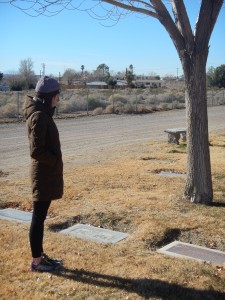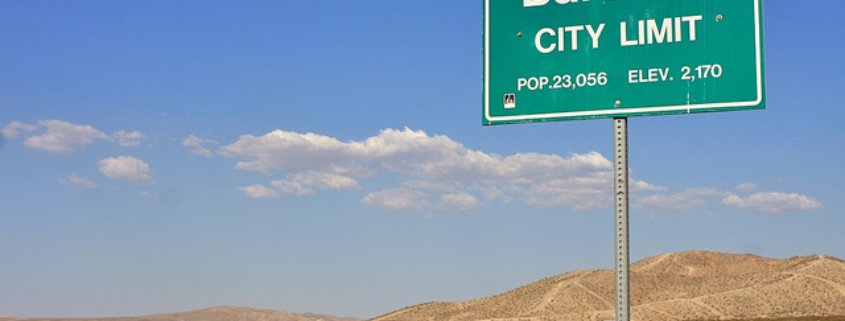Barstow: A Love Story
 I spent the first day of the new year in Barstow, a small city in the high desert just over a hundred miles east of Los Angeles. I was there with my spouse and children to lay flowers on the graves of family members buried at Mountain View Memorial Park. From a distance, irregularly planted trees were all that distinguished the rows of flat stone grave markers in a swath of close-cropped yellowed grass from the surrounding desert. The morning sun was low on the horizon and intense in a cloudless blue sky. It was cold for Southern California—below 40º F. As I climbed out of the car, I jammed gloved hands into my jacket pockets.
I spent the first day of the new year in Barstow, a small city in the high desert just over a hundred miles east of Los Angeles. I was there with my spouse and children to lay flowers on the graves of family members buried at Mountain View Memorial Park. From a distance, irregularly planted trees were all that distinguished the rows of flat stone grave markers in a swath of close-cropped yellowed grass from the surrounding desert. The morning sun was low on the horizon and intense in a cloudless blue sky. It was cold for Southern California—below 40º F. As I climbed out of the car, I jammed gloved hands into my jacket pockets.
The cemetery is located on Barstow’s northern boundary, past the BNSF rail yard and across State Route 58. It feels remote, though it’s only four miles from Barstow Station, the busy railway-themed rest stop just past the junction of interstates 15 and 40. Authentic rail cars provide dining space for Barstow Station’s eateries and typify the city’s identity as a logistics hub.
Barstow’s location midway between Los Angeles and Las Vegas to the north, and Flagstaff to the east, earned the city its reputation as “Crossroads of Opportunity.” Today, eighteen-wheelers travel highways and interstates that replaced the Old Spanish Trail, the arduous trade route through the high mountains, deserts, and deep canyons between Santa Fe and Los Angeles, and the Salt Lake Road that Mormons traveled in the early nineteenth century. Later, in 1883, Southern Pacific constructed a railway between Mohave and Needles, California to serve miners who converged in the area when silver and gold were discovered in nearby Calico and Daggett, respectively.
Though Barstow is still associated with travel and shipping, the city’s primary employer is now the military. Fort Irwin National Training Center (NTC) and the Marine Corps Logistics base together employ twenty-five times more people than the city’s next biggest employer, the BNSF Railway. Demographically, Barstow’s population mirrors the U.S. military today. It’s diverse, yet racially whiter and blacker than San Bernardino county or California, where Latinos predominate. Most residents pursue education beyond high school, but few ever earn a bachelor’s degree. And while military service can pay well, Barstow’s low median household income—$39,000, compared to $54,000 for the county and $61,000 for the state—suggests most NTC and Marine logistics personnel are not topping their branch pay scales.

Downtown Barstow was deserted on New Year’s. The few Main Street businesses still in operation were closed and strip mall parking lots were empty. Absent the usual traffic and activity, the low-slung, stone gray buildings blended into the pavement, weathered asphalt, and the dusty desert sand. This desperate city, epitomized in Kevin Sheridan’s Leaving Barstow, is a place not worth staying in unless “something’s wrong with you.” The impoverished, isolated desert road stop and those who inhabit it—struggling mother, new girlfriend, teacher, boss, and best friend, in particular—provide the context for the film’s protagonist, Andrew, to wrestle with his opportunity to leave home.
* * *
“Place is emotion,” according to Dorothy Allison, author of the autobiographical Two or Three Things I Know for Sure. It integrates the physical details—the colors, sounds, tastes, temperatures, and textures—and emotional cues that provide the reader/viewer with the information necessary to form a picture in her mind’s eye. Writing about place requires a close reading of a location’s sensual landscape and attention to the ways its inhabitants interact with one another and their surroundings. John Steinbeck visited Arvin Federal Government Camp for migrant workers and studied reports compiled by the camp’s director, Tom Collins, before writing The Grapes of Wrath. Jim Rawley in Grapes obviously channels Collins; more importantly, Collins’s extensive documentation of conditions in immigrant camps provided the historical information necessary for Steinbeck’s construction of place. Chimamanda Ngozi Adichie’s Americanah draws on the author’s own life as a Nigerian immigrant who becomes “black” in America. Adichie interrogated the ways in which she herself navigated identity, race and place as a black woman in the American cultural context to create the novel’s protagonist, Ifemelu.
* * *
My paternal grandparents are among the family members buried in Barstow. Their story unfolds with the expansion of goods movement in Southern California and the westward migration of an established Midwestern family. Still it resists easy identification with the desolate Barstow of Sheridan’s film. Rather, it reveals a Barstow that more closely resembles the small Iowa towns they grew up in than a collection of affordable neighborhoods for passing soldiers and low-wage workers drawn to the area by the Tangiers outlets and the promise of a casino and resort.
My grandmother, Stella, was an Iowa farmer’s daughter whose part-time job was selling peanuts at the movie theater in town. Lyle, my grandfather, was the young man who developed a taste for silent films, just so he could buy peanuts from his girl. They married, became parents to four children, including my father, and moved across the country to California via Kansas City, Missouri. Lyle was a driver and manager for Yellow Freight Transit (now a subsidiary of Yellow Roadway Corporation), first in Orange County and then in Barstow.
Post retirement, he and Stella stayed put in their small desert home. Stella had grown to love the sunsets that filled the sky, the mountains on the horizon, and the company of their children and grandchildren who all lived within driving distance. As a child I loved visiting my grandparents in Barstow. My siblings and I would spend hours exploring via the city’s flood channels accessible from the ditch behind my grandparents’ back yard. We’d return hungry, hot, and flushed to fight over the corner stool at the bar, the only seat in the house where you could simultaneously eat, watch TV, and enjoy the cool air coming from the swamp cooler in the hall.
 Stella died quietly in her sleep at the end of a long day spent with their children, one arm across her husband’s chest. Nearly every day after Stella’s burial, Lyle visited her grave at Barstow’s Mountain View Memorial Park. The groundskeeper often stopped his work to watch him. My grandfather sat for hours on a stone bench near the sapling that was planted to shade his “peanut girl’s” final resting place—a quiet spot near the edge of the park with a clear view of Black Mountain and the surrounding wilderness. He was tall, despite a pronounced stoop, and thin, with white-gray hair that stood up with the slightest wind. He’d lean forward over his knees and worry his fingers as if smoking, whether or not he had a cigarette at hand.
Stella died quietly in her sleep at the end of a long day spent with their children, one arm across her husband’s chest. Nearly every day after Stella’s burial, Lyle visited her grave at Barstow’s Mountain View Memorial Park. The groundskeeper often stopped his work to watch him. My grandfather sat for hours on a stone bench near the sapling that was planted to shade his “peanut girl’s” final resting place—a quiet spot near the edge of the park with a clear view of Black Mountain and the surrounding wilderness. He was tall, despite a pronounced stoop, and thin, with white-gray hair that stood up with the slightest wind. He’d lean forward over his knees and worry his fingers as if smoking, whether or not he had a cigarette at hand.
One day, he stopped visiting, and the groundskeeper moved the bench.
Lyle was buried with Stella on a warm April morning in the spot of shade provided by new leaves on a rapidly growing a tree. That tree, tall now and full in spring, is the first thing we look for when we bring flowers to lay on their grave. The simple gray headstone in a patch of grass at the base of the tree is a reminder that Barstow is a place where enduring love stories unfold.
Juliann Allison is a feminist scholar, environmentalist, homeschool advocate, yogini, runner, rockclimber, mate, and mother of four with a passion for the outdoors. She is Associate Professor of Gender and Sexuality Studies and Public Policy at UC Riverside, and an MFA student at Antioch University Los Angeles.






